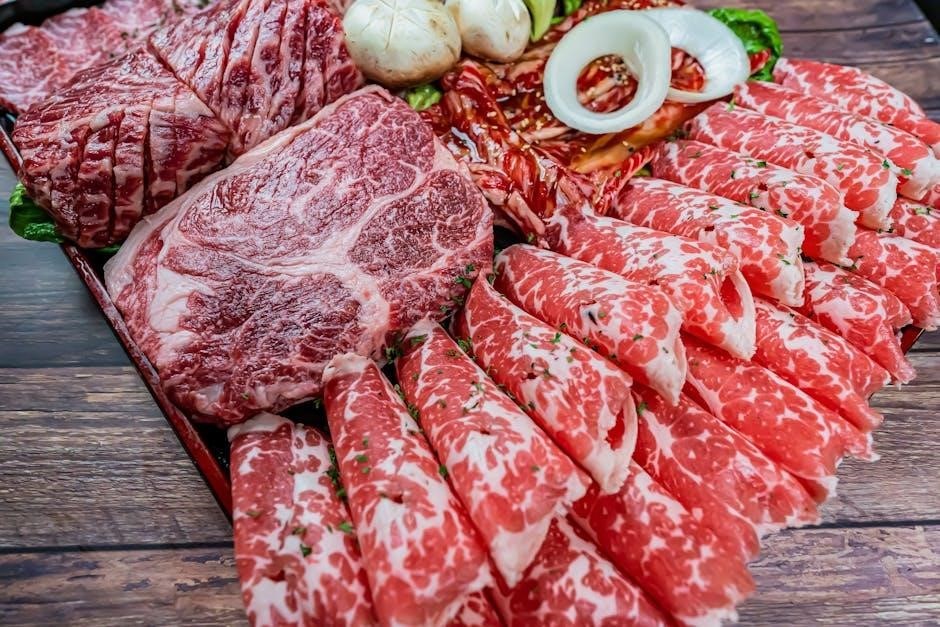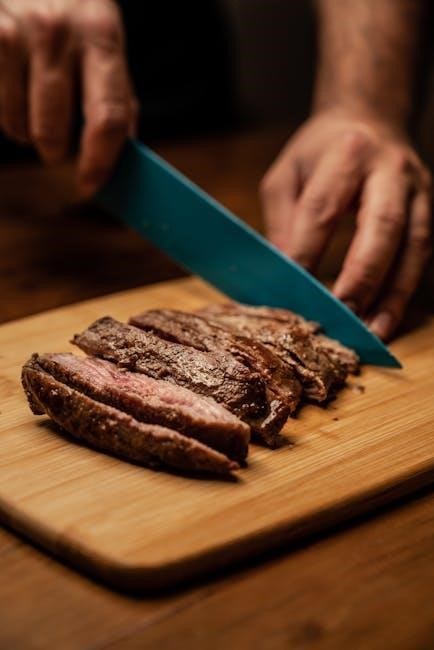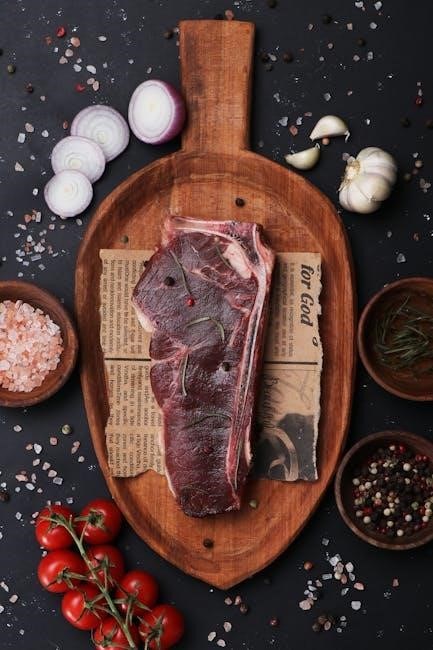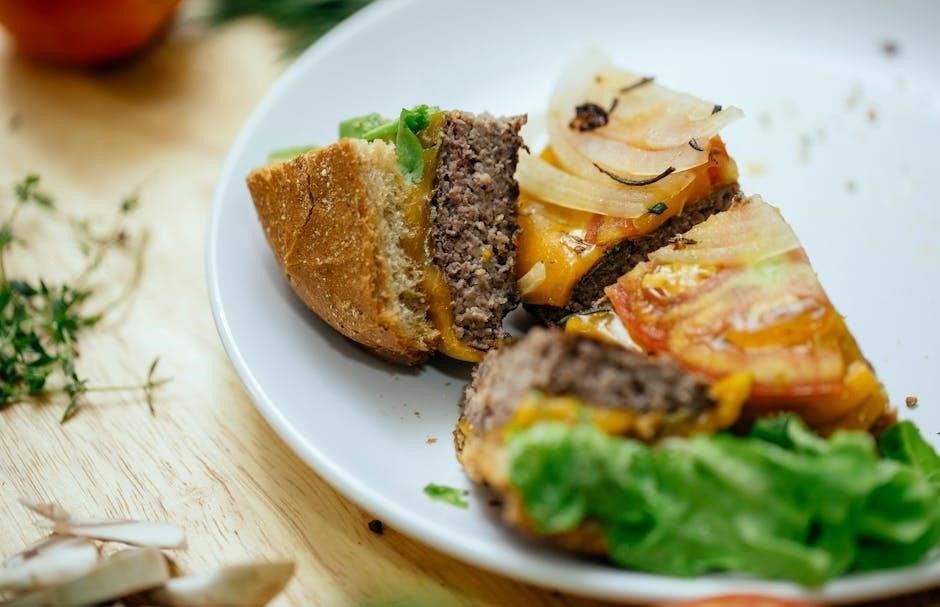A beef cuts chart provides a visual guide to understanding the different sections of a cow, their locations, and ideal cooking methods. It simplifies meal planning and enhances culinary skills by showcasing primal, sub-primal, and retail cuts, helping users make informed decisions for various recipes and cooking techniques.
1.1 Overview of Beef Cuts and Their Importance
Beef cuts are categorized into primal, sub-primal, and retail sections, each with unique characteristics. Understanding these divisions is crucial for selecting the right cut for specific recipes and cooking methods. Primal cuts, like chuck and loin, are divided into smaller sub-primal cuts, which are further processed into retail cuts such as steaks and roasts. Recognizing these distinctions ensures optimal flavor, tenderness, and cooking results, making beef cuts essential for both home cooks and professional chefs.
1.2 Purpose of a Beef Cuts Chart
A beef cuts chart serves as a visual guide to understanding the various sections of a cow, their locations, and the best cooking methods for each cut. Its purpose is to simplify the process of selecting and preparing beef, ensuring optimal flavor and texture. By providing a clear overview of primal, sub-primal, and retail cuts, the chart empowers home cooks and professionals to make informed decisions, enhancing their culinary skills and meal planning efficiency.
Primal Beef Cuts
Primal beef cuts are the initial divisions of the carcass, including chuck, rib, loin, and round. These large sections are further divided into sub-primals for retail use.
2.1 Definition and Classification of Primal Cuts
Primal cuts are the primary divisions of a beef carcass, representing the largest initial sections. They are classified based on anatomical areas, such as the chuck from the shoulder, rib from the midsection, loin from the back, and round from the hindquarters. These cuts are significant as they determine the quality, tenderness, and suitability for various cooking methods, making them the foundation for further processing into sub-primals and retail cuts.
2.2 Major Primal Cuts and Their Characteristics
The major primal cuts include chuck, rib, loin, and round. Chuck, from the shoulder, is rich in flavor with more fat and connective tissue, making it ideal for slow cooking. The rib section offers tender, flavorful meat, perfect for roasts. The loin, from the back, is lean and highly tender, often used for steaks. The round, from the hindquarters, is lean and firmer, suitable for roasts or steaks. Each cut’s characteristics influence its culinary use.

Sub-Primal and Retail Beef Cuts
Sub-primal cuts are smaller, more specific portions derived from primal cuts, offering greater versatility. Retail cuts, like steaks and roasts, are consumer-ready, making cooking easier and more accessible for home use.
3.1 Understanding Sub-Primal Cuts
Sub-primal cuts are smaller sections cut from primal cuts, offering precise portion control and versatility. These cuts are further divided into retail cuts like steaks, roasts, and ground beef. They are ideal for specific cooking methods, such as grilling, roasting, or stir-frying. A beef cuts chart PDF provides detailed visuals, helping users identify sub-primal cuts and their best uses, enhancing both meal planning and cooking efficiency.
3.2 Popular Retail Cuts and Their Uses
Popular retail cuts include flank steak, ribeye, sirloin, and brisket. Flank steak is ideal for stir-fries and fajitas, while ribeye excels in grilling and pan-frying. Sirloin is versatile for roasting or grilling, and brisket is perfect for slow-cooking methods. A beef cuts chart PDF highlights these cuts, providing images and descriptions to help users identify and select the best options for their desired dishes, ensuring optimal flavor and texture in various culinary applications.
Beef Cut Anatomy
Beef cut anatomy explains how cuts are divided based on the cow’s musculoskeletal structure. Primal cuts like chuck, rib, and loin come from specific anatomical sections, influencing tenderness and flavor. Understanding this anatomy helps in selecting the right cuts for various cooking methods, ensuring optimal results in dishes ranging from roasts to steaks.
4.1 Location of Cuts on the Cow
Beef cuts are derived from specific anatomical sections of the cow. Primal cuts like chuck, rib, and loin are taken from the front, middle, and rear sections, respectively. Sub-primal cuts are further divided based on muscle groups and bone structure. Understanding the origin of each cut helps in identifying its tenderness, flavor, and suitability for various cooking methods, making it easier to plan meals and achieve desired culinary results effectively.
4.2 Relationship Between Cut Location and Cooking Methods
The location of beef cuts on the cow directly influences their texture and fat content, determining the best cooking methods. Cuts from muscular areas, like the chuck, are tougher and benefit from slow cooking or braising. Tender cuts, such as those from the loin or rib, are ideal for grilling or roasting. Understanding this relationship ensures optimal flavor and texture, making meal preparation more efficient and enjoyable for home cooks and professionals alike.

Cooking Methods for Different Beef Cuts
Cooking techniques vary based on the cut’s tenderness and fat content. Slow cooking is ideal for tougher cuts, while grilling suits tender cuts like steaks and roasts.
5.1 Recommended Cooking Techniques for Each Cut
Matching the right technique to the cut ensures optimal flavor and texture. Tougher cuts like chuck thrive with slow-cooking methods like braising or stewing, breaking down connective tissue. Tender cuts, such as ribeye or sirloin, are ideal for grilling or pan-frying. Lean cuts benefit from marinating before grilling or roasting. Ground beef is versatile for patties or stir-fries. Using a meat thermometer ensures proper internal temperatures for safety and doneness, while cooking against the grain enhances tenderness in cuts like flank steak.
5.2 Lean vs. Fat Cuts: Cooking Considerations
Lean cuts, like sirloin, require higher heat for searing to retain moisture, while fat cuts, such as brisket, benefit from slow cooking to break down marbling. Lean cuts are less forgiving, needing precise timing to avoid dryness. Fat cuts stay juicy due to marbling, making them ideal for low-and-slow methods. Always use a meat thermometer to ensure safe internal temperatures, and consider marinating lean cuts for added flavor and tenderness before cooking.

Beef Cuts Chart PDF: Features and Benefits
A Beef Cuts Chart PDF offers a comprehensive, downloadable guide, detailing primal and sub-primal cuts, their locations, and cooking methods, aiding in meal planning and culinary preparation.
6.1 What to Look for in a Beef Cuts Chart
When selecting a beef cuts chart, look for one that clearly identifies primal, sub-primal, and retail cuts, their locations on the cow, and recommended cooking methods. Ensure it includes high-quality visuals, detailed descriptions, and possibly lean designations. A good chart should also provide information on marbling, tenderness, and flavor profiles, making it user-friendly for both home cooks and professionals. Opt for a chart that is updated and reflects current industry standards for accuracy and relevance.
6.2 How to Use the Chart for Meal Planning
Start by identifying the recipe or cooking method you prefer, then use the chart to find the most suitable beef cut. Cross-reference the cut’s location, tenderness, and flavor profile to ensure it matches your dish. Adjust portion sizes or cooking techniques based on the chart’s recommendations. This tool helps in planning balanced meals, exploring new recipes, and optimizing your grocery list for the best culinary results every time.

Beef Cut Quality and Grading
Beef quality is determined by factors like marbling, tenderness, and flavor, with grades indicating the cut’s excellence. Higher grades offer richer taste and smoother texture, enhancing culinary experiences.
7.1 Understanding Beef Quality Designations
Beef quality designations refer to grading systems that evaluate factors such as marbling, tenderness, and maturity. In the United States, the USDA grading system categorizes beef into grades like Prime, Choice, and Select, based on marbling and maturity. Marbling, the intramuscular fat, enhances flavor and tenderness. Higher grades like Prime have abundant marbling, while lower grades like Select have less, impacting the cooking methods and the final dining experience.
7.2 Marbling and Tenderness in Different Cuts
Marbling, the distribution of intramuscular fat, significantly impacts beef tenderness and flavor. Cuts with high marbling, like those from the rib section, are naturally tender and rich in flavor. Lean cuts, such as sirloin or round, may require tenderization techniques. The relationship between marbling and tenderness varies across cuts, with fattier cuts generally offering a more luxurious texture and taste, while leaner cuts provide a firmer bite and are often better suited for slow cooking or stir-fries.
Beef Cuts in Culinary Applications
Beef cuts are essential in culinary applications, offering a variety of options for restaurants and home cooks. Tender cuts like ribeye are perfect for grilling, while tougher cuts like brisket excel in slow-cooked dishes. Cultural preferences also influence cut choices, with some favoring lean cuts for stir-fries and others opting for richer, fattier cuts for roasts.
8.1 Restaurant and Foodservice Uses
Beef cuts are versatile in restaurant and foodservice settings, catering to diverse culinary needs. Primal cuts like ribeye and sirloin are ideal for steaks, while chuck is often ground for burgers. Brisket and shank are popular for slow-cooked dishes, such as BBQ and stews. Restaurants use sub-primal cuts to ensure consistency in portion sizes and flavors, enhancing menu planning and customer satisfaction. This approach maximizes efficiency and quality in commercial kitchens.
8.2 Cultural Variations in Beef Cut Preferences
Cultural differences significantly influence beef cut preferences worldwide. In some regions, lean cuts like sirloin are favored for grilling, while others prefer fattier cuts for marbling and flavor. For example, Asian cuisines often use thinly sliced beef for stir-fries, whereas European traditions might opt for larger roasts. These preferences reflect local cooking methods, traditional dishes, and cultural attitudes toward food, showcasing a rich diversity in how beef is valued and prepared globally.
Choosing the Right Beef Cut
Selecting the right beef cut involves considering cooking methods, desired tenderness, and flavor preferences. Use a beef cuts chart to match cuts with your meal goals effectively.
9.1 Factors to Consider When Selecting a Cut
When selecting a beef cut, consider the cooking method, desired tenderness, and fat content. Lean cuts are ideal for quick cooking, while fattier cuts thrive with slow cooking. The size and thickness of the cut also matter, as they affect cooking time. Using a beef cuts chart can help identify the best cut for your recipe, ensuring a perfect balance of flavor and texture. Always match the cut to your cooking goals for optimal results.
9.2 Matching Cuts to Cooking Goals
Matching beef cuts to cooking goals ensures optimal results. Tender cuts like ribeye or sirloin are perfect for grilling or pan-frying, while tougher cuts like brisket or shank excel with slow cooking methods. Flank steak, with its robust flavor, is ideal for stir-fries or marinades. Using a beef cuts chart helps pair the right cut with your desired cooking technique, whether you’re aiming for a juicy roast or a flavorful braise.
A beef cuts chart is an essential tool for understanding beef sections and their ideal cooking methods, enhancing meal planning and culinary skills. Use it wisely to elevate your cooking.
10.1 Summary of Key Points
Understanding beef cuts and their classifications is crucial for effective meal planning and cooking. Primal cuts, such as chuck and loin, are divided into sub-primal and retail cuts, each with unique characteristics. Knowing their locations on the cow and recommended cooking methods ensures optimal flavor and tenderness. A beef cuts chart simplifies this process, providing a visual guide to enhance culinary skills and make informed decisions for various recipes and cooking techniques.
10.2 Final Thoughts on Using a Beef Cuts Chart
A beef cuts chart is an indispensable tool for cooks and chefs, offering clarity on primal, sub-primal, and retail cuts. It aids in selecting the right cut for specific dishes, ensuring optimal flavor and texture. By understanding the origin and best cooking methods for each cut, users can elevate their culinary skills and make informed decisions, making it a must-have resource for any kitchen.